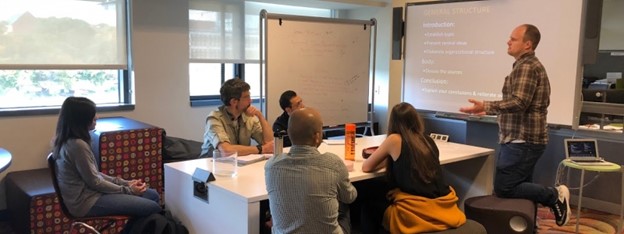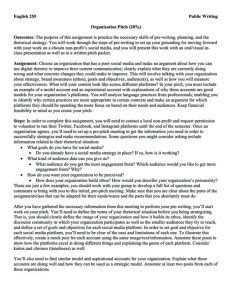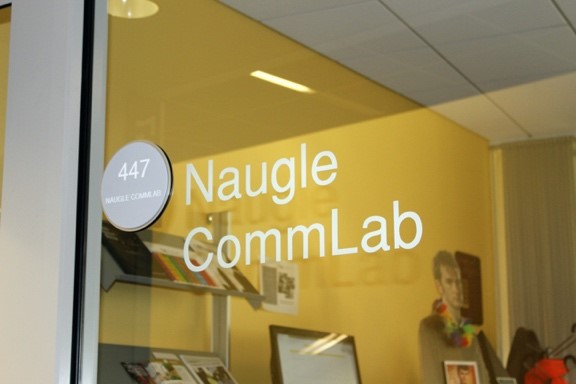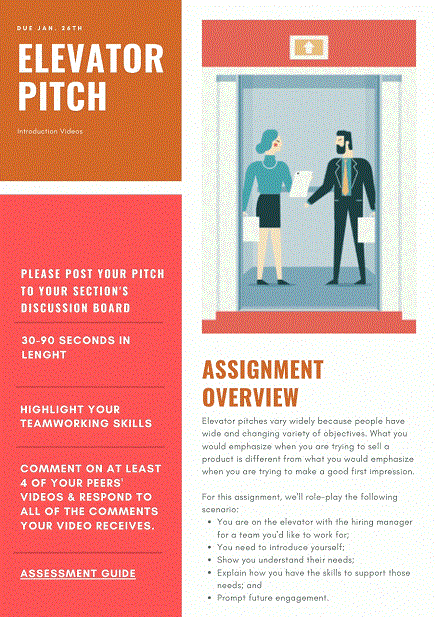
Jeffrey Howard teaches a workshop in the Naugle CommLab (2019).
By Jill Fennell and Jeffrey Howard
“We build the corral as we reinvent the horse.” ~ Stephen Dunn, “A Little Essay on Form”
Introduction
In his “Little Essay on Form,” noted writer Stephen Dunn argues that even when writers work within the constraints of generic conventions, they also can reshape those constraints. This license applies not only to creative genres, such as personal essays or poetry, but also to technical documents, such as assignment sheets. Years of teacher lore (traditional knowledge and practices passed from instructor to instructor) have taught many new instructors how to assemble an assignment sheet for their students, and as a result many fossilized assumptions about what an assignment sheet ought to be and do in the context of a classroom remain with us. We can learn much from teacher lore about how to function in the university classroom, but like many things traditional sometimes it needs to be adapted to fit new needs and contexts. We argue that is the case regarding assignment sheets, which are an academic genre in need of reimagining for the 21st-century classroom. Assignment sheets can and should function as models of information design that not only 1) provide scope and direction for student work, but can also 2) prompt classroom discussion of design conventions, tools, and processes; 3) model aesthetically pleasing and rhetorically sound design choices to underscore principles taught in the class; and 4) reinforce student confidence in the instructor by showing them that the instructor possesses knowledge about rhetorical strategies as well as the ability to put that knowledge into practice. However, the current wisdom and literature on effective assignment design and classroom use relies too heavily on tradition and anecdote, and we argue that more empirical research needs to be done regarding the usability of assignment sheets in communication-related courses. We link our call for this kind of data with best practices and offer recommendations based on principles found in technical communication scholarship for re-envisioning current assignment sheet practices.
Literature Review

Figure 1: Fennell’s Organization Pitch Assignment Sheet (2019). This assignment sheet depicts overpacked text and a poor use of negative space.
This project is born out of professional experience. We, like many other new college-level instructors, began by writing assignment sheets like those of our teachers and peers: single-spaced black text on a white background. We have made technical mistakes such as burying assignment requirements in lengthy paragraphs and neglecting to use typefacing (bolding, italicizing, underlining, etc.) to its fullest potential. We have even packed text onto one page by making margins smaller under the assumption that multi-page assignment sheets might intimidate students, thus hindering their comprehension of the instructor’s directions and the objectives of their assigned tasks (see Figure 1). However, we have since realized that such choices made our assignment sheets poor models of effective communication. As Marion L. Brittain Postdoctoral Fellows, we endeavored to design assignment sheets that better adhere to our writing program’s focus on WOVEN (written, oral, visual, electronic, and nonverbal) communication and, as a result, attempt to increase student engagement, buy-in, and learning from an assignment’s outset.
Our prior poor design decisions partially reflect a dearth of research on assignment sheet design. Indeed, the research that does exist on assignment sheets most often focuses on how to help students “decode” assignment sheets in their traditional design rather than offering instructors methods for improving their designs to more effectively achieve their rhetorical purposes. Linda Simon’s oft-quoted article, “De-Coding Writing Assignments,” examines some differences between how teachers intend assignment sheets to be used and what about assignment sheets frustrate students—particularly how assignment sheets can be too vague to provide adequate direction. While vagueness and ambiguity in assignment sheets present issues, for some the opposite, being too rigid and directive, is also problematic. In fact, during a teaching observation, James Marshall criticized an assignment sheet that was “so highly structured…that the direction of the students’ arguments has been virtually predetermined” (157). This critical conversation illuminates the difficult balance between designing instructional material that provides enough detail for a successful final product to put students at ease without devaluing invention in the composition process.
One thing the literature does suggest is that assignment sheets themselves can function as classroom texts that promote critical reading and thinking in our students. They do not have to be documents that essentially exist in the background of the class, being distributed about the room merely as a means of telling students what their tasks are and how to accomplish them, etc. Instead, they can also come to the foreground of the class’s attention, prompting discussions about composition and communication. For example, Simon gives recommendations on how teachers can help students use the assignment sheets to better understand expectations. Instead of prescribing how to design more effective assignment sheets, Simon argues, “By helping students to de-code our assignment,” we can get them to think more about the writing process (155). Anna Kendall builds upon this emphasis on reading and interpretation in “The Assignment Sheet Mystery”; Kendall writes from the perspective of a writing center consultant to make arguments on how consultants can use assignment sheets to improve consultations during any part of the student’s writing process. Through this argument, she expands Simon’s advice on assignment sheet use. However, like Simon, Kendall does not make any additional recommendations on what assignment sheets should do or how they should look.
As for concrete recommendations or expectations of the assignment sheet genre, scholarship poses few, or, perhaps, expects an unspoken universal understanding. David Sudol’s short essay, “Rhetorical Situations and Assignment Sheets,” does state that he “include[s] rhetorical situations in [his] assignment sheets,” which is certainly not something all teachers include (52). This decision to include explicit information about elements such as context, language, conventions, persona/voice, message, and purpose helps students understand how exigence gives way to rhetorical decisions. However, this suggestion is only a drop in the bucket of what assignment sheets can be and do differently to help our students learn and grow new skills.

Assignment sheets play an important function not just for students, but also for the support systems such as writing labs and tutoring services put in place to help students succeed.
Our argument is significant because we suggest that easily made changes to ubiquitous educational aids such as assignment sheets can dramatically influence students’ abilities to learn and practice new learning objectives and concepts. Assignment sheets are ideally revised before and after terms based on instructors’ experience and students’ feedback, but these changes almost always take shape in the exact same form on the educational aid: black text on a white background. This article attempts to merge what we teach with how we teach. This is exciting because it provides us more opportunities to model and discuss the concepts key for course success; furthermore, if we genuinely believe what we are teaching works, then these changes will make our teaching aids more capable of achieving their rhetorical purpose.
The challenge here is the balance of this merger of pedagogy, technical writing, and information design. The teaching of writing and communication has many of the same goals as technical communication: we want those using our documents to be able to do three things: 1) find, 2) understand, and 3) appropriately use information. However, the difference arises because the needs of the relationship between a technical writer and a technical document user is quite different than the relationship between a teacher and a student. In “What is Information Design?” Janice C. Redish points out that “[t]he users, not the information designer, decide how much time and effort to spend trying to find and understand the information they need” (163). Yet, the activity involved in education requires students to develop the cognitive skills to stretch beyond their current abilities, and the practice of this stretching relies on the need— and indeed the expectation— for a greater expenditure of effort on the part of the student. While some might balk at the idea, assignment sheets are in fact texts that often introduce students to new ideas, phrases, and operations as a start to the learning process. For this reason, assignment sheets are necessarily going to be more difficult for their readers than Redish advises; however, teachers’ design decisions on their instructional materials can make a big difference in this learning process.

Figure 2: Fennell’s Elevator Pitch Assignment Sheet (2021). This assignment sheet demonstrates how technical communication strategies can inform assignment sheet design. (Click on the image to see the full .gif.)
Our research, as presented in this article, brings up an interesting question: As we use information design to develop user-based assignment sheets, what responsibility do we have to maintain our students’ statuses as students—as opposed to users or consumers—and to what level should we communicate our own rhetorical choices and reasons to our students? We believe that students are always students first, and we prioritize this against the tide of the increasing tendency to view students as consumers. As we make suggestions for how technical communication strategies can be used for instruction design, we encourage our readers, to remember the distinction between students and users—especially as the student’s position necessitates growth and challenge as opposed to ease and efficiency. The topic of assignment sheet design is not new, but given the ubiquity of this genre in the academy, the topic remains a significant one for both students and their instructors. Much of what instructors still do–or fail to do–with their assignment sheet is connected to practices that have been ongoing for decades. In fact, 25 years ago Marilyn Dyrud wrote about how instructors needed to do a better job designing their assignment sheets to help students navigate these documents (1). She goes on to discuss about how some of these basic “design considerations,” including headings and sub-headings; information chunking through judicious use of white space and bulleted lists; and other features like varied text sizes, bolding, italics, and underlining, would do much to assist students in understanding the objectives, expectations, and processes involved in classroom artifact production (2).
Dyrud’s perspective was a start for thinking about ways to resolve the problems presented by assignment sheet design, but because it is typical of the document design approach popular in the 1990s, it is now somewhat outdated. Karen Schriver writes, “Document designers must understand how readers might think and feel as they interact with documents. They must anticipate what their audiences need and expect” (152). Technical communication has moved beyond document design to information design (which, according to Carliner, accounts for and “encompasses not only graphics, text, and reader goals, but also the goals of the sponsor who commissioned the text” [564]). However, many instructors have not moved beyond an implied document design approach when putting together their assignments because assignment sheet design frequently depends upon principles derived from teacher lore rather than current scholarship or design theory.
In the next installment of this article, we will discuss ways to apply information design and technical communication scholarship to assignment sheets and the ways we use them in the classroom to enrich student learning. We will also discuss the implications of our ideas as they relate to prioritizing and protecting our students’ identities as students rather than treating them as consumers. Finally, our works cited page for this article will also appear at the end of the next installment.
